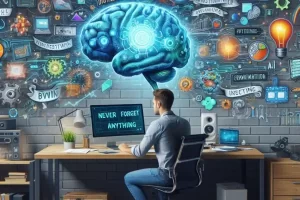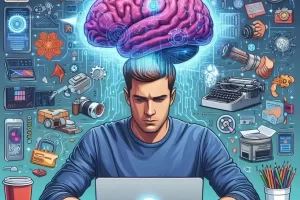A second brain isn’t just a place to store notes — it’s a tool for better thinking. And when you integrate artificial intelligence, your second brain can become a powerful decision-making assistant. Instead of second-guessing your instincts or sifting through piles of information, you can use AI to bring clarity, surface insights, and help you choose with confidence.
In this article, you’ll learn how to use your AI-powered second brain to support smarter decisions — whether you’re planning your career, choosing a business strategy, or solving everyday problems.
Why Decision-Making Needs a System
Every day, you make dozens of decisions — some small, some life-changing. But making great decisions requires:
- Clear information
- Relevant context
- Pattern recognition
- Emotional distance
Without a system, you end up:
- Forgetting what you already know
- Repeating past mistakes
- Relying on incomplete data
- Feeling overwhelmed or reactive
That’s where your second brain — especially with AI — becomes your thinking partner, not just a digital notebook.
Step 1: Record Your Decision Context
Smart decisions begin with clarity. When you’re facing a choice, start by capturing:
- The problem
- Your options
- Pros and cons
- Risks and rewards
- Your emotions or biases
Use a decision template in Notion or Obsidian with these fields. Then ask ChatGPT to help you clarify:
“Summarize the pros and cons of these two options.”
“What are the potential risks of Option A?”
“Which option aligns most with my long-term goals?”
This allows you to externalize your thinking — and let AI support it.
Step 2: Surface Past Notes and Decisions
Your second brain is full of relevant knowledge — if you can find it.
Prompt your AI to:
- “Show past decisions related to this topic.”
- “What were the lessons I noted from my last product launch?”
- “Do I have any notes tagged with ‘market research’ or ‘pricing strategy’?”
This makes your current decision informed by experience, not guesswork.
Step 3: Use AI to Simulate Scenarios
Ask your AI to simulate what might happen based on each choice. For example:
- “If I choose Option A, what outcomes might I expect over the next 6 months?”
- “What’s the best-case and worst-case scenario for switching careers?”
- “How might this decision affect my time, income, and energy?”
AI can help you think through consequences more clearly than trying to juggle it all in your head.
Step 4: Reduce Bias with Objective Analysis
AI doesn’t have your emotional blind spots. Ask it to challenge your thinking.
Try prompts like:
- “Play devil’s advocate for this decision.”
- “What assumptions am I making that may be incorrect?”
- “List any cognitive biases that could be influencing my thinking.”
This step adds critical distance to your process — the kind you’d usually only get from a coach or mentor.
Step 5: Convert Insight Into Action
Once you’ve made a decision, don’t stop there. Let your second brain help you turn it into a plan.
Ask:
- “Break this decision into 5 action steps.”
- “Create a timeline for implementation.”
- “What are the first 3 tasks I should do next week?”
Now your decision becomes momentum, not mental clutter.
Step 6: Track Results Over Time
Smart decision-making improves with feedback. Your second brain should log:
- What decision you made
- Why you made it
- What happened as a result
- What you learned
You can then prompt:
- “What patterns do I notice in decisions that worked out well?”
- “What factors often lead to regret or failure?”
- “How can I improve future decisions based on these results?”
This builds a decision intelligence layer into your life.
Step 7: Use AI to Help You Prioritize
Sometimes, the hardest part isn’t deciding between two options — it’s choosing what to focus on next.
Ask ChatGPT:
- “Based on my goals, what are my top 3 priorities this month?”
- “Of these 5 tasks, which will have the highest impact?”
- “What should I delegate or delay?”
AI can help cut through noise and guide you toward what matters most.
Bonus: Use Decision-Making Frameworks with AI
Combine frameworks with AI for next-level thinking. Examples:
- Eisenhower Matrix: Ask AI to categorize tasks by urgency/importance
- SWOT Analysis: “Run a SWOT analysis on this business idea”
- First Principles Thinking: “Help me break this problem down to its core truths”
- Regret Minimization: “How might I feel about this decision in 5 years?”
Your second brain becomes a thinking toolkit, powered by frameworks and guided by AI.
Real-Life Example: Business Owner Choosing a Marketing Strategy
Let’s say you’re trying to decide between investing in SEO or paid ads. Here’s how your second brain helps:
- You capture your goals and available budget
- You record pros/cons of each strategy
- AI summarizes key market research from your notes
- You ask ChatGPT to simulate outcomes and identify risks
- AI creates a 4-week implementation plan
- You schedule a check-in in 30 days to review results
That’s how you move from uncertainty to action, with clarity.
Final Thoughts: Let Your Brain Decide, Let AI Guide
AI won’t make decisions for you. But it can give you the tools, structure, and insight to make better decisions faster — with less stress and second-guessing.
Your second brain, powered by AI, becomes your personal strategist: surfacing what you already know, helping you think clearly, and turning choices into progress.
In a world full of noise, this is your competitive advantage.




